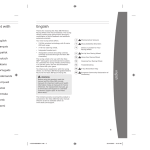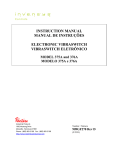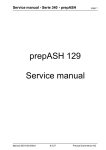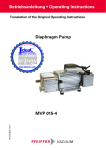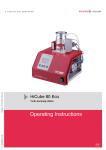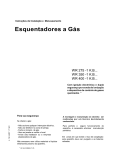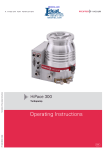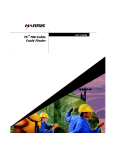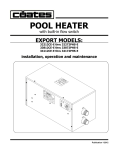Download Rotary Vane Pump DUO 5 M DUO 5 MC
Transcript
Betriebsanleitung • Operating Instructions Rotary Vane Pump DUO 5 M PK 0197 BE/G (0603) DUO 5 MC INDEX Page 1. Safety Precautions .................................. 3 1.1. For Your Orientation........................................................... 3 1.2. Pictogram Definitions........................................................ 3 2. Understanding The Pump........................ 4 2.1. Main Features..................................................................... 4 Proper Use.................................................................................... 4 Improper Use................................................................................ 4 2.2. Differences Between The Pump Types.......................... 4 3. Installation ............................................... 5 3.1. Preparations For Installation............................................ 5 3.2. Pump Set-Up And Location .............................................. 5 3.3. Connecting The Vacuum Side.......................................... 5 3.4. Connecting The Exhaust Side .......................................... 5 3.5. Connecting To The Mains Power Supply....................... 6 4. Operations ................................................ 7 4.1. Filling Up And Checking The Operating Fluid ................ 7 4.2. Switching The Pump ON And OFF................................... 7 4.3. Extracting Dry Gases And Vapours................................. 8 5. What To Do In Case Of Breakdowns? .......................................... 9 6. Maintenance .......................................... 10 6.1. Replacing The Operating Fluid....................................... 10 6.2. Cleaning And Replacing The Silencer.......................... 11 6.3. Shutting Down For Longer Periods ............................... 11 7. Service .................................................... 12 8. Technical Data ....................................... 13 8.1. Dimensions........................................................................ 13 9. Accessories............................................ 14 10. Spare Parts ............................................. 15 10.1 Spare Parts Package....................................................... 15 10.2. Exploded view................................................................... 16 Declaration Of Contamination .................... 17 Conformity Declaration ................ (last page) 2 Please note: Current operating instructions are also available via www.pfeiffer-vacuum.net. 1. Safety Precautions ☞ Read and follow all the instructions in this manual. ☞ Inform yourself regarding: – Hazards which can be caused by the pump; – Hazards which can arise in your system; – Hazards which can be caused by the medium being pumped. ☞ Avoid exposing any part of your body to vacuum. ☞ Observe all safety and accident prevention regulations. ☞ Check regularly that all safety requirements are being complied with. ☞ Do not use the pump for the purpose of generating pressure. ☞ Do not carry out any unauthorised conversions or modifications on the pump. ☞ When returning the pump to us please note the shipping instructions in the section on service. The following safety instructions are only relevant when dismantling the drive system. ☞ When dismantling the drive system from the pump casing the powerful magnetic field of the coupling system can influence the function and operational safety of electrical and electronic units. BEWARE 1.2. Pictogram Definitions BEWARE WARNING WARNING CAUTION Strong magnetic field! Danger of personal injury. Danger of personal injury. Danger of burns from touching hot parts. Danger of damage to the pump or system. Persons who have a heart pacemaker must stay outside the area of influence of magnetic fields. There is a danger of life. ☞ Do not place the dismantled magnetic coupling in the vicinity of computers, data carriers and other electronic components. ☞ On no account allow the two parts of the magnetic coupling to come into contact. There is a danger of crushing. ☞ Keep all magnetisable parts away from the magnetic coupling. There is a danger of personal injury. ☞ PLEASE NOTE Attention to particularly important information on the product, handling the product, or to a particular part of the documentation. 1.1. For Your Orientation Instructions in the text ➡ Operating instruction: Here, you have to do something. Symbols used The following symbols are used throughout in the illustrations: Vacuum flange Exhaust flange Gas ballast valve Power connection Position numbers Identical pump and accessory parts have the same position numbers iin all illustrations. Modifications reserved 3 2. Understanding The Pump 2.1. Main Features New drive concept with integrated magnetic coupling Rotary Vane Vacuum Pump DUO 5/DUO 5 C Vacuum flange Exhaust flange Gas ballast valve 26 28 42 80 110 142 144 198 200 280 Power connection Support stand Casing Housing gas ballast valve Base plate Sight glass O-ring for operating fluid drain screw O-ring for operating fluid filler screw Operating medium drain screw Operating fluid filler screw Motor Proper Use 28 200/144 110 42 – Rotary Vane Vacuum Pumps may only be used to generate vacuum. – Installation, start-up, operating and maintenance instructions must be observed. – Accessories other than those named in this manual may not be used without the agreement of Pfeiffer Vacuum. Improper Use 280 80 26 198/142 The DUO 5/5C is a dual stage rotary vane vacuum pump with magnetic coupling for various applications in the rough and medium vacuum. The separation of the rotor and motor shaft eliminates the problem of the radial shaft seal providing a hermeticalled sealed pump. The wear-free drive prevents leaks, minimizes maintenance and increases the MTTF. During intentional and unintentional shutdowns, an integrated high-vacuum safety valve immediately separates the pump from the vacuum chambers and vents the pump. Applications: – Mass Spectrometry – Backing pump for turbos – Any Lab-Application 4 The following are regarded as improper: – The pumping of corrosive gases (except with corrosive gas processes version). – The pumping of explosive gases. – Operating the pump in locations where there is an explosion hazard. – The pumping of gases which are contaminated with particles, dust and condensate. Avoid condensation and sublimation; take note to the vapour compatability. – The Pump may not be used for the purpose of generating pressure. – The pumping of liquids. – Connection to pumps and units which is not permitted according to their operating instructions. – Connection to units which contain touchable and voltage carrying parts. Improper use will cause any rights regarding liability and guarantees to be forfeited. 2.2. Differences Between The Pump Types Pump versions DUO 5 = Standard pump version DUO 5 C = Corrosive gas processes version pump Divergences to the standard pump version: – operating fluid F4 – encapsulated can of the magnetic coupling – different material for the vanes – gas vallast valve with hose connection 3. Installation 3.1. Preparations For Installation 3.3. Connecting The Vacuum Side At pumps with three phase motors check the direction of rotation before filling in the operating fluid. Pumps with single phase motors are not concerned. ➡ Keep the connection between the vacuum chamber and pump as short as possible. ➡ Remove all scaling and loose particles from welded lines prior to assembly. – To protect the pump, separators, filters and cooling traps etc.(see Section 9. Accessories) can be fitted upstream of the pump. However, the conductance values of the accessory causes a reduction in volume flow rate. – For the intake lines, metal or PVC hoses with small flanges are available. CAUTION Fill up with operating fluid before operating the first time (included in a separate pack in the delivery consignment). When filled with operating fluid, do not tilt the pump otherwise operating fluid could escape via the vacuum and exhaust flanges. 3.4. Connecting The Exhaust Side 3.2. Pump Set-Up And Location When transporting, use only the handle provided for the purpose. ➡ Where stationary installation is involved, anchor the pump on site. ➡ Sight glass 110 on the front side must be visible and the gas ballast valve readily accessible. ➡ When installing the pump in a closed housing, ensure there is sufficient air circulation. Pressure can rise to dangerous levels in exhaust lines. Therefore, exhaust lines, which should be of minimum diameter DN 16, should not be fitted with shut-off units. Lay lines from the pump sloping downward so that no condensate can flow back into the pump. Otherwise fit a separator. If exhaust gases are extracted, the exhaust pressure must not fall below 250 mbar . Forces from the piping system may not be allowed to act on rotary vane pumps which are anchored. All piping to the pump must be suspended or supported. CAUTION Maximum angle of inclination to each side 10° Maximum erection height 2000 m N.N Maximum and minimum ambient temperature 40 °C and 12 °C respectively Maximum relative humidity 85% max. 10° 5 3.5. Connecting To The Mains Power Supply Single phase motor CAUTION Power connections must comply with local regulations. Voltage and frequency information given on the rating plate must correspond to the mains voltage and frequency values. The DUO 5/DUO 5 C is fitted with a single phase motor with integrated thermal protection switch, power button and connecting cable as standard. DUO 5 with single phase motor Checking The Direction Of Rotation ➡ Remove locking cap from the exhaust flange . ➡ Switch on for a short time (2 ... 3 seconds) Motor/motor fan must turn clockwise (see arrow on support stand). ➡ If direction of rotation incorrect: Interchange two phases on the connecting cable. ➡ Fill in operating fluid. The motor protection switch has been set according to the nominal voltage levels provided. Three phase motors with PTC The motors of these pumps are fitted with three PTCs which are built into the stator windings. The connection of a tripping unit and a contactor in the power supply line (according the wiring diagram) will protect the pump against overloading. Power part with motor to be protected CAUTION The transmission power of the pump’s magnetic coupling is so great that there is no overload protection for the motor. Three phase motor When switching on pumps with three phase motors for the first time, check the direction of rotation: WARNUNG 6 Always check the direction of rotation without operating fluid filled in, otherwise operating fluid could eject via the vacuum flange. Use a tripping unit with error signal storage, e.g. a PTC tripping unit with two switchover contacts at the output (see Section 9. Accessories). 4. Operations PLEASE NOTE 26 28 42 80 110 198 200 280 ☞ Rotary Vane Pump DUO 5/DUO 5 C Vacuum flange Exhaust flange Gas ballast valve Power connection Support stand Casing Housing gas ballast valve Base plate Sight glass Operating fluid drain screw Operating fluid filler screw Motor 28 200 110 42 Operating fluid must be disposed of in accordance with local waste disposal regulations. ➡ Remove operating fluid filler screw 200. ➡ Fill up with operating fluid included in the consignment; refer to rating plate for correct quantity and typ of operating fluid. ➡ Replace operating fluid filler screw 200; be careful with the O-ring. ➡ Check operating fluid level only when the pump is warm and running and vacuum connection and gas ballast valvel and operating fluid filler screw are closed. ➡ The level should be between the two markings on sight glass 110. The minimum level is the lower marking on sight glass 110. ➡ Topping up operating fluid is possible when the pump is in final vacuum operations. ➡ In non-stop operations check operating fluid daily, otherwise whenever the pump is switched on. 4.2. Switching The Pump ON And OFF 280 80 26 198 The pump can be switched ON and OFF in any pressure range. Lowest start-up temperature, in compliance with German Industrial Standard DIN 28 426: +12 °C. On switching OFF (intake pressure < 750 mbar) the built-in high vacuum safety valve to the vacuum chamber closes automatically and the pump is vented. WARNING 4.1. Filling Up And Checking The Operating Fluid Standard version pumps are tested with operating fluid P3. Guarantees relating to attainment of final pressures and trouble free functioning apply only providing this operating fluid is used. The delivery consignment contains sufficient operating fluid for one filling. Pumps for special applications (e.g. for pumping corrosive gases) can be operated with special operating fluids such as F4 and other Pfeiffer Vacuum operating fluids. The use of such operating fluids requires prior authorisation from the manufacturer. CAUTION PLEASE NOTE ☞ CAUTION Danger of burns when touching hot parts! During operations temperatures of obove 70°C can arise at the pump`s surface! Protect pump by means of suitable measures (e.g. dust separator) when the pumped gases are contaminated with particles or dust. If necessary check operating fluid regular or change operating fluid more frequent. To make shure that the high vacuum safety valve works proper at any intake pressure, there should be at least a pressure difference of 250 mbar between the intake and the exhaust side. 7 4.3. Extracting Dry Gases And Vapours Gas ballast valve No special measures are necessary providing the correct pump version is being operated (selection of operating fluid, materials etc.). To avoid condensation in the pump, vapours should only be pumped off when the pump is warm and with gas ballast valve open. Note pump water vapour compatibility levels under Section 8. Technical Data. When the process has been completed, allow the pump to continue running for about 30 minutes with open gas ballast valve for operating fluid regeneration purposes. CAUTION Gas Ballast Valve (Standard Version) Air is periodically fed into the working chamber at the beginning of the compression phase via the gas ballast valve. The gas ballast valve is shut when turning to the right to position 0 and open when turning to the left to position 1. Intermediate settings are not possible. Gas Ballast Valve (Corrosiv Gas Version) If the pumping process requires the connection of flushing gas, an elbow fitting can be provided for the gas ballast valve in c version (please refer to Chapter 10. Spare Parts). ➡ Connect flushing gas at the gas ballast inlet 224. ➡ Adjust pressure of sealing gas. ➡ Open gas ballast valve. ☞ HINWEIS Flushing gas pressure may not exceed 1.5 bar (absolute). The type of flushing gas is dependent on the medium being pumped. Our specialists would be pleased to give advice regarding the type and volume of flushing gas required. Gas ballast valve 224 Elbow fitting (c version) 224 8 closed open 5. What To Do In The Case Of Breakdowns? Problem Pump doesn't attain final pressure Unusual operating noises Pump doesn't start Possible Cause • Pump dirty • Operating fluid dirty • • • • • • Leak in system Silencer dirty Pump stage damage Ambient temperature <12 °C Dirty pump stages Damaged pump stages Remedy • Cleaning the pump • Operate pump for a longer period with open gas ballast valve or change operating fluid • Repair leak • Clean silencer or change as per section 6.2. • Request repair by Pfeiffer Vacuum Service • Warm up pump • Request cleaning by Pfeiffer Vacuum Service • Request repair by Pfeiffer Vacuum Service Any other repairs may only be carried out by qualified personnel in conjunction with the service instructions. 9 6. Maintenance When carrying out servicing work, take the following precautions: Always ensure the pump cannot be switched WARNING on when carrying out any work on the pump. If necessary, remove the pump from the system to carry out inspection work. ➡ Only dismantle the pump as far as is necessary in order to repair defects. ➡ Dispose of used operating fluid in compliance with local regulations. ➡ When working with synthetic operating media, toxic substances and substances contaminated with corrosive gases, the relevant instructions governing their use must be observed. ➡ Only use benzine or similar agents for cleaning pump parts. Do not use soluble cleaning agents. WARNING The operating fluid temperature can be as high as 80 °C. During maintenance and repair work, process related toxic gases and vapours can escape from the operating fluid which may become contaminated with harmful substances (radioactive, chemical etc.). Disposal of used operating fluid is subject to the relevant regulations. ➡ Screw in operating fluid drain screw 198. ➡ Allow pump to run for about 10 seconds with open vacuum flange. ➡ Drain off remaining operating fluid. ➡ In the case of serious contamination, the operating fluid will have to be changed several times. ➡ Screw in operating fluid drain screw 198 with O-ring. ➡ Fill in fresh operating fluid and check level as per section 4.1. 6.1. Changing The Operating Fluid The rate of deterioration of the operating fluid depends on the pump applications. ➡ The level of deterioration of organic operating fluids (for example P3) can be read off from the colour scale in accordance with DIN 51578 on the supplementary sheet PK 800 219 BN/B, on request. – The colour scale enables precise colour determination. ➡ Fill a specimen in a test tube or some similar vessel and test by holding against the light. ➡ Where the discolouration is dark yellow to red brown (equivalent to 4 ... 5 on the scale) change operating fluid. CAUTION Where organic operating fluids, for example P3, are involved, the operating fluid should be changed at least once a year! Replacing The Operating Fluid ➡ Switch off the pump. ➡ Unscrew operating fluid drain screw 198 and drain operating fluid. 10 WARNING Operating fluid can contain substances from the medium pumped. Operating fluid must be disposed of in accordance with the local respective regulations. Please request safety instruction data sheets for operating fluids from Pfeiffer Vacuum. 6.2. Cleaning And Replacing The Silencer 6.3. Shutting Down For Longer Periods The Silencer 44 is a nozzle inside the pump housing and cannot be altered; when dirty it should either be cleaned or replaced. Should the pump have to be shut down for an longer period, the complete pumping system must be adequately protected against corrosion. Dismantling ➡ Unscrew 2 cheesehead screws 182 from the casing. ➡ Remove the gas ballast valve housing 42 from the casing 28, taking care with o-ring 148. ➡ Unscrew silencer nozzle 44 and remove in vertical direction; take care with o-ring 138. ➡ Clean silencer nozzle 44 and o-ring and replace if necessary. ➡ Switch off pump. ➡ Unscrew operating fluid drain screw 198 and drain operating fluid as per Section 6.1. ➡ Screw in operating fluid drain screw 198; keep an eye on the position of the O-ring. ➡ Allow pump to run for about 10 seconds with open vacuum flange. . ➡ Drain off remaining operating fluid. ➡ Fill up pump with fresh operating fluid: filling level - upper end of sight glass 110. If this amount of operating fluid is filled in, the level is extremely high but this is necessary to protect all parts of the pump against corrosion. Dismantling silencer 28 42 44 51 138 141 148 182 211 224 Casing Gas ballast valve housing Silencer nozzle Leaf spring O-ring O-ring O-ring Cheesehead screws Washer Elbow-fitting CAUTION 182 42 Before operating, the operating fluid must be reduced to its normal level. 28 141* 224* 211 44 138 51 148 * C version 11 7. Service Before Returning: ➡ Dismantle all accessories. ➡ Drain lubricant. ➡ Attach a clearly visible notice: “Free of contamination” (to the unit being returned, the delivery note and accompanying paperwork). Harmful substances" are substances and preparations as defined in current legislation. Pfeiffer Vacuum will carry out the decontamination and invoice this work to you if you have not attached this note. This also applies where the operator does not have the facilities to carry out the decontamination work. Units which are contaminated microbiologically, explosively or radioactively cannot be accepted as a matter of principle. Fill Out The Contamination Declaration ➡ In every case the "Contamination Declaration" must be completed diligently and truthfully. ➡ A copy of the completed declaration must accompany the unit; any additional copies must be sent to your local Pfeiffer Vacuum Service Center. Please get in touch with your local Pfeiffer Vacuum representatives if there are any questions regarding contamination. 12 WARNING Decontaminate units before returning or possible disposal. Do not return any units which are microbiologically, explosively or radioactively contaminated. Returning Contaminated Units If contaminated units have to be returned for maintenance/repair, the following instructions concerning shipping must be followed without fail: ➡ Neutralise the pump by flushing with nitrogen or dry air. ➡ Seal all openings to the air. ➡ Seal pump or unit in suitable protective foil. ➡ Ship units only in appropriate transport containers. PLEASE NOTE ☞ Do Make Use Of Our Service Facilities In the event that repairs are necessary to your pump, a number of options are available to you to ensure any system down time is kept to a minimum: – Have the pump repaired on the spot by our Pfeiffer Vacuum Service Engineers; – Return the individual components to the manufacturer for repairs; – Replace individual components with a new value exchange units. Local Pfeiffer Vacuum representatives can provide full details. Repair orders are carried out according to our general conditions of sale and supply. ➡ If repairs are necessary, please send the unit together with a short damage description to your nearest Pfeiffer Vacuum Service Center. 8. Technical Data Feature Unit DUO 5/DUO 5 C Connection nominal diameter Input Output DN 16 ISO-KF DN 16 ISO-KF Nominal pumping speed at 50 Hz 60 Hz Pumping speed at 50 Hz 60 Hz m3/h m3/h 5.5 6.6 m3/h m3/h 5 6 Final pressure Total without gas ballast Total with gas ballast Exhaust pressure,, min. Exhaust pressure, max. mbar mbar mbar mbar < 5 • 10-3 < 2 • 10-2 > 250 < 1500 mbar mbar 25 28 g/h g/h 90 120 Water vapour compatibility 50 Hz 60 Hz Water vapour capacity 50 Hz 60 Hz Noise level without gas ballast Alternating current version dB(A) Three phase current version dB(A) Operating fluid l Max. permissible operating temperature ÞC (at 25 °C ambient temperature and operating fluid P3, without gas ballast) Rotation speed at 50 Hz 60 Hz Rated power, motor Alternating current version Three phase current version Weight, approx. Alternating current version Three phase current version 57 55 0.75 80 1/min 1/min 1415 1690 kW kW 0.37 0.25 kg kg 22 19 8.1. Dimensions DUO 5/DUO 5 C 145 47 61 M 58 4,5 215 H 18 DN 16 ISO-KF 3 65 o7 79 107 216 100-114 o 7 variabel 135 248 L L H M Pump with three phase motor 433 204 (without motor protection switch) 223 (with motor protection switch) 215 Pump with alternating current motor 435 mm 221 mm 160 PK197_massb 217 mm 13 9. Accessories Description Size Number Dust Separator STP 025 DN 25 ISO-KF PK Z60 106 Oil Mist Filter Oil Return Unit Condensate Separator Cooling Trap Adsorption Filter Adsorption Filter ONF 16 ONFR KAS 16 KLF 025 FAK 025 FBL 025 ZFO 0252) DN 16 ISO-KF PK Z40 003 PK 196 172 -T PK Z10 003 PK Z80 006 PK Z30 006 PK Z30 106 Zeolite Trap PTC Tripping Unit Operating Fluid F4 Operating Fluid F4 Operating Fluid F4 DN 16 ISO-KF DN 25 ISO-KF DN 25 ISO-KF DN 25 ISO-KF DN 25 ISO-KF 1 litre 0,5 litre 0,25 litre 2) Filled with zeolite. Please refer to the Pfeiffer Vacuum catalogue “Components For Vacuum Technology” for further accessories, or on request. 14 PK Z70 006 P 4768 051 FQ PK 005 887 -T PK 005 886 -T PK 005 885 -T Comments/ Operating Instructions only with adapter DN 25/16 (PK 800 120 BN) PK 800 213 BN PK 800 213 BN PK 800 220 BN PD 0015 BN PD 0017 BN PD 0017 BN PD 0016 BN Order Quantity 10. Spare Parts Set of seals The set of seals contains all seals including all o-rings of the subassemblies. Maintenance kit The pack contains the o-rings of the operating fluid filler and drain screw for changing the operating fluid. Also the o-ring for the casing after cleaning the operating fluid sump is included. Overhaul kit The pack contains all wearing parts of the pump to replace the following parts after dismantling the whole pump: – Set of seals – Wearing parts of the pumping system – Wearing parts of the vacuum safety valve – Wearing parts of the gas ballast valve Set of vacuum safety valve The pack contains the wearing parts of the vacuum safety valve. Also the o-rings between valve housing and pumping system and the o-ring of the casing are included. Set of discharge valves The pack contains the wearing parts of the discharge valves. Also the wearing parts of the exhaust valve and the o-ring of the casing are included. Coupling kit The pack contains the coupling halfs, can and the respective o-ring. 10.1 Spare Parts Package Pump type Revision index DUO 5 DUO 5 C up to “B” wizhout Set of seals PK E30 005 -T PK E30 005 -T Maintenance kit Overhaul kit PK E31 004 -T PK E31 004 -T PK E32 008 -T PK E32 006 -T Vacuum safety valve PK E34 004 -T PK E34 004 -T Discharge valves PK E35 002 -T PK E35 002 -T Spare parts package No. Parts according to the exploded view on the following pages Set of seals PK E30 005 -T 76, 112 138, 141, 142, 144, 147, 148, 149, 150, 152, 154, 156, 158, 160, 162, 254. Maintenance kit PK E31 004 -T 138, 144, 162. Overhaul kit PK E32 008 -T PK E32 006 -T PK E30 005 -T, 7, 8, 9, 10, 32, 44, 51, 100, 102, 106, 110, 114. PK E30 005 -T, 7, 8, 9, 10, 32, 44, 51, 100, 102, 106, 110, 114. Vacuum safety valve PK E34 004 -T 30, 32, 34, 70, 100, 106, 108, 147, 152, 154, 160, 188, 204, 208, 220, 250. Discharge valves PK E35 002 -T 100, 102, 184, 204, 208. Coupling kit PK E36 005 -T PK E36 006 -T 18, 20, 24, 184, 254. 18, 20, 24, 184, 254. ☞ PLEASE NOTE The use of other spare parts than mentioned in this instruction requires prior authorisation from Pfeiffer Vacuum. The spare parts packages listed above are only valid for the pumps in standard versions. When ordering please be sure to state the full information given on the rating plate. Coupling kit PK E36 005 -T PK E36 006 -T Only authorized, experienced and trained personnel are permitted to make changes or perform maintenance or repairs. Unapproved changes by the customer void all warranty and liability claims against Pfeiffer Vacuum. Please use our Service Training offers (information is also available via www.pfeiffer-vacuum.net). 15 10.2.Exploded view 42 78/ 138/ 141/ 148 76/ 142 } 78 7 8 9 10 18 20 24 30 32 34 42 9 162 51 44 144 110/ 112 188 30 84 142 7/ 10 8/ 10 34 204/ 152 70/208/ 100 32 147 250 188 106 154/ 160 220 108 102 184 254 158 20 44 51 70 76 78 80 84 100 102 106 108 110 112 114 138 141 142 144 147 148 149 150 152 154 158 160 162 188 184 204 208 220 250 254 149 Vanes, rough stage Vanes, medium stage Hydraulic vanes Compression spring Central coupling, drive Central coupling, pump Can Housing high vacuum safety valve Valve plate Valve cover for vacuum safety valve Housing gas ballast valve (further parts see Section 6.2.) Silencer screw Plate spring (gas ballast valve) Valve trap Rapid action coupling Compression spring Base plate Oil nozzle Valve buffer Valve plate Hydraulic piston Compression spring, vacuum safety valve Sight glass Sight glass seal Rubber foot O-ring O-ring O-ring O-ring O-ring O-ring O-ring O-ring O-ring O-ring O-ring O-ring O-ring Allan head screw Allan head screw Circlip Compression spring for valve buffer Screw Compression spring for vacuum safety valve O-ring 150 PK200/1 24 16 184 80 18 114 Declaration of Contamination of Vacuum Equipment and Components The repair and/or service of vacuum components will only be carried out if a correctly completed declaration has been submitted. Non-completion will result in delay. The manufacturer could refuse to accept any equipment without a declaration. This declaration can only be completed and signed by authorised and qualified staff: 1. Description of component: 2. Reason for return: - Equipment type/model: _________________________ _____________________________________________ - Code No.: __________________________ _____________________________________________ - Serial No.: __________________________ _____________________________________________ - Invoice No.: __________________________ _____________________________________________ - Delivery Date: __________________________ _____________________________________________ 3. Equipment condition 4. Process related contamination - Has the equipment been used? yes ❐ no ❐ of equipment - toxic yes ❐ no ❐ - What type of pump oil was used? ___________________________________________ - corrosive yes ❐ no ❐ - microbiological hazard*) yes ❐ no ❐ - Is the equipment free from potentially harmful substances? yes ❐ (go to section 5) no ❐ (go to section 4) - explosive*) yes ❐ no ❐ - radioactive*) yes ❐ no ❐ - other harmful substances yes ❐ no ❐ *) We will not accept delivery of any equipment that has been radioactively or microbiologically contaminated without written evidence of decontamination! Please list all substances, gases and by-products which may have come into contact with the equipment: Tradename Product name Manufacturer Chemical name (or Symbol) Danger class Precautions associated with substance Action if spillage or human contact 1. 2. 3. 4. 5. 5. Legally Binding Declaration I hereby declare that the information supplied on this form is complete and accurate. The despatch of equipment will be in accordance with the appropriate regulations covering Packaging, Transportation and Labelling of Dangerous Substances. Name of Organisation: _______________________________________________________________________________ Address: _____________________________________ Post code: _____________________________________ Tel.: ______________________________________________________________________________________ Fax: _____________________________________ Name: ______________________________________________________________________________________ Job title: ______________________________________________________________________________________ Date: _____________________________________ Telex: ________________________________________ Company stamp: ________________________________ Legally binding signature: _____________________________________________________________________________ 17 Konformitätserklärung Declaration of Conformity im Sinne folgender EU-Richtlinien: pursuant to the following EU directives: - Maschinen/Machinery 98/37/EG (Anhang/Annex IIA) - Elektromagnetische Verträglichkeit/Electromagnetic Compatibility 89/336/EWG - Niederspannung/Low Voltage 2006/95/EG Hiermit erklären wir, daß das unten aufgeführte Produkt den Bestimmungen der EU-Maschinenrichtlinie 98/37/EG, der EU-Richtlinie über Elektromagnetische Verträglichkeit 89/336/EWG und der EU-Niederspannungsrichtlinie 2006/95/EG entspricht. We hereby certify, that the product specified below is in accordance with the provision of EU Machinery Directive 98/37/EEC, EU Electromagentic Compatibility Directive 89/336/EEC and EU Low Voltage Directive 2006/95/EC. Produkt/Product: DUO 5 M, DUO 5 MC Angewendete Richtlinien, harmonisierte Normen und angewendete nationale Normen in Sprachen und Spezifikationen: Guidelines, harmonised standards, national standards in languages and specifications which have been applied: DIN EN ISO 12100-1, -2 EN 294 EN 50 081-1, -2 EN 61 010 EN 60335-1, -41 EN 60 204 EN 1012-2 Unterschriften/Signatures: Pfeiffer Vacuum GmbH Berliner Str. 43 35614 Asslar Germany Unterschriften: (M. Bender) Geschäftsführer Managing Director (Dr. M. Wiemer) Geschäftsführer Managing Director Konf.I/2007 Vacuum is nothing, but everything to us! Turbo Pumps Rotary Vane Vacuum Pumps Roots Pumps Dry Vacuum Pumps Leak Test Units Valves Flanges, Feedthroughs Vacuum Measurement Gas Analysis System Technology Service Pfeiffer Vacuum Technology AG · Headquarters/Germany Tel. +49-(0) 64 41-8 02-0 · Fax +49-(0) 64 41-8 02-2 02 · [email protected] · www.pfeiffer-vacuum.net




















